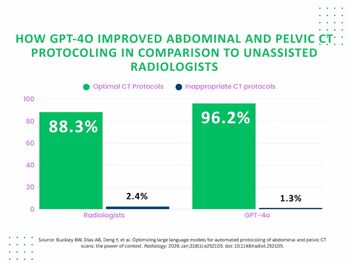
Iterative Reconstruction Techniques Reduce Pediatric Head CT Dose
Radiation doses for pediatric head CT imaging can be significantly reduced through use of adaptive statistical iterative reconstruction technique.
Use of an adaptive statistical iterative reconstruction technique (ASIR) significantly reduced the radiation dosage in pediatric head CTs, according to a study presented today at the 2014 AARS Annual Meeting in San Diego, Calif.
Researchers from Massachusetts General Hospital and Harvard Medical School sought to determine if radiation doses from pediatric head CT examinations would change if ASIR was used. “CT radiation dose is an important concern with all imaging sites, especially for children,” coauthor Ranish Deddar Ali Khawaja said in a release. “We performed this study to do a preliminary analysis of pediatric head CT examinations and to assess the factors influencing radiation doses.”
A total of 451 head CTs from 429 patients under age 19 (258 male, 173 female) were evaluated for the study. Two-hundred eighty-eight CT exams were performed on the S1 64-MDCT Lightspeed VCT GE Healthcare scanner (statistical IRT ASIR+), 110 on the S2 64-MDCT Discovery 750HD scanner (ASIR+), and 53 on the S3 16-MDCT Lightspeed Pro (ASIR-).
The patient cohort was divided into five age subgroups: 91 in group A1 (infants, under 3 years, n=91), 57 in group A2 (toddlers, aged three to six), 30 in group A3 (children from seven to 10 years, 83 in group A4 (older children, from 11 to 14 years) and 190 in group A5 (adolescents, from 15 to 18 years). The subjects were also divided in two effective diameter subgroups based on median diameter (17 cm): D1, equaling 17 cm (n= 243); and D2, greater than 17 cm (n= 208).
The researchers compared mean radiation doses age subgroups, gender, effective diameter subgroups and scanner type: ASIR+ versus ASIR-.
The findings showed that the brain and salivary gland doses were much lower for the ASIR+ exams, compared to those that were ASIR-. However, there were no differences in the estimated organ doses for the thyroid gland, skeleton and eye lenses across the ASIR+ and ASIR- cohorts.
The CT exams that were reconstructed with ASIR had significantly lower dose compared to exams performed on scanners without ASIR reconstruction capability (SSDE, 22 ± 13 mGy vs. 29 ± 17 mGy respectively).
Mean size specific dose estimate (SSDE) was significantly different across age subgroups:
Mean SSDE was also significantly different across effective diameter subgroups:
There was no significant difference in dose across boys (22 ± 13 mGy) and girls (22 ± 13 mGy).
The researchers concluded that estimated radiation doses are substantially lower for head CT scans among children when ASOR+ technology is used, with a mean reduction of approximately 24 percent. There is also a significant reduction in dose output to brain and salivary glands.
Newsletter
Stay at the forefront of radiology with the Diagnostic Imaging newsletter, delivering the latest news, clinical insights, and imaging advancements for today’s radiologists.




























